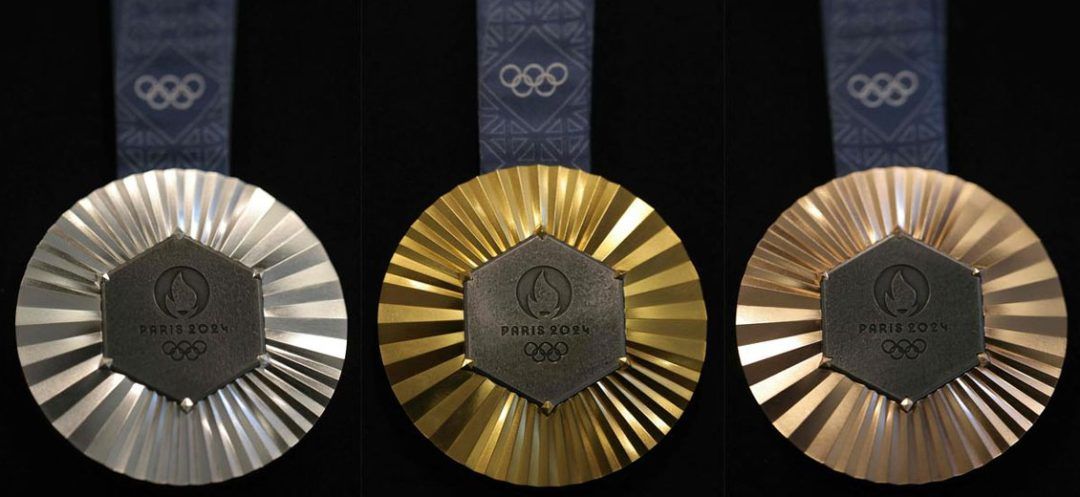
Combining French heritage and sporting excellence, the medals for the Paris 2024 Olympic and Paralympic Games make history with their unique design. Incorporating a piece of the Eiffel Tower, they embody the spirit of innovation and the universal values of Olympism.
When athletes stand on the podiums of the Paris 2024 Olympic and Paralympic Games, they will receive much more than just a sports award. The medals that will adorn their necks are true works of art, carrying history and symbolism.
Unveiled on February 8, 2024, by the Paris 2024 organizing committee, these medals result from a close collaboration between the Chaumet jewelry house, part of the LVMH group, and the Paris 2024 Athletes’ Commission, chaired by the renowned biathlete Martin Fourcade.
The design of the medals revolves around three key elements: the hexagon, the radiance, and the setting. At the center of each medal is a hexagonal piece of iron from the Eiffel Tower, reminiscent of the shape of France and symbolizing the country’s mobilization for these Games. Fine lines radiate from this central hexagon, creating an effect that evokes both France’s global influence and the athletes’ performance. Finally, the iron hexagon is set in the medal using a technique inspired by the “clous de Paris,” recalling the rivets of the Iron Lady.
A Piece of History in Each Medal
The most remarkable element of these medals is undoubtedly the inclusion of an authentic piece of the Eiffel Tower. Each medal contains an 18-gram hexagon of puddled iron from the famous Parisian monument. This iron, stripped of its “Eiffel Tower brown” paint, regains its original color and fits perfectly within the gold, silver, and bronze medals.
This bold initiative allows medal-winning athletes to take home a real piece of French heritage, creating a tangible link between their sporting achievement and the history of France.
Unity and Diversity: One Common Side, Two Distinct Stories
Paris 2024 chose to bring the Olympic and Paralympic Games closer by offering a common side to the medals of both events. This side, set with Eiffel Tower iron, symbolizes the unity and inclusiveness of the Games.
The other side of the medals, however, tells two distinct stories. For the Olympic medals, the traditional symbols imposed by the International Olympic Committee are found: the goddess of victory Athena Nike, the Panathenaic Stadium, and the Acropolis, along with an exceptional representation of the Eiffel Tower. The Paralympic medals, on the other hand, feature a bird’s-eye view from beneath the Eiffel Tower, with the inscription “Paris 2024” in universal Braille.
Strong Symbols, Bearing Universal Values
Beyond their innovative design, these medals carry strong symbols and universal values. The gold medal symbolizes self-surpassing, recalling the feats of athletes who push their limits. The flame, present on the central hexagon, represents the unique energy that runs through this event and invites boldness and innovation.
The inclusion of Marianne, the emblematic figure of the French Republic, on the Games’ emblem, recalls the values of humanism, fraternity, and sharing, common to sport and the Olympic spirit.
An Object of Desire and Pride
Measuring 85 mm in diameter and 9.2 mm thick, these medals are true objects of desire and pride for athletes. They represent the culmination of their dreams and efforts while embodying French history and culture.
The medal ribbon, inspired by the crisscross patterns of the Eiffel Tower, adds an extra touch of elegance and symbolism. Blue for the Olympic Games and red for the Paralympic Games, it recalls the historical colors of the Iron Lady.
The medals for the Paris 2024 Olympic and Paralympic Games are a blend of history, innovation, and universal values. By incorporating a piece of the Eiffel Tower, they offer athletes the chance to take home a tangible fragment of French heritage, while symbolizing sporting excellence and the spirit of innovation.
These unique medals will undoubtedly remain in the annals as one of the most striking symbols of these Games, embodying both the cultural richness of France and the fundamental values of Olympism and Paralympism.
Read more




Comments